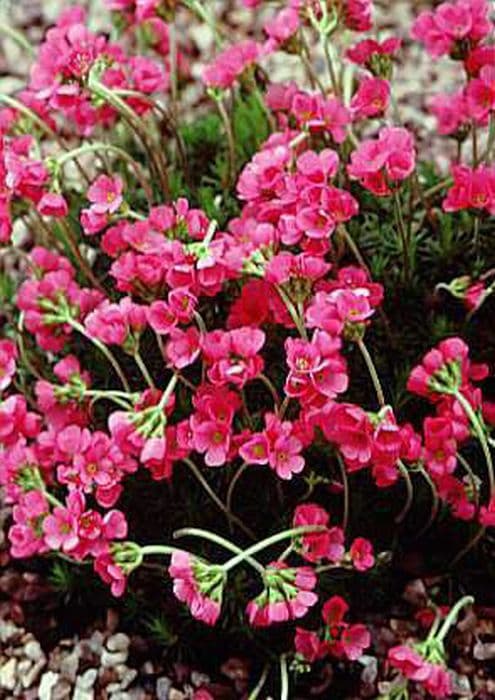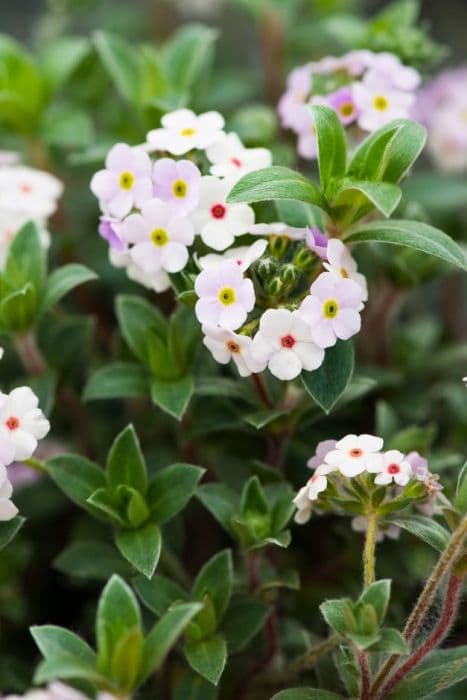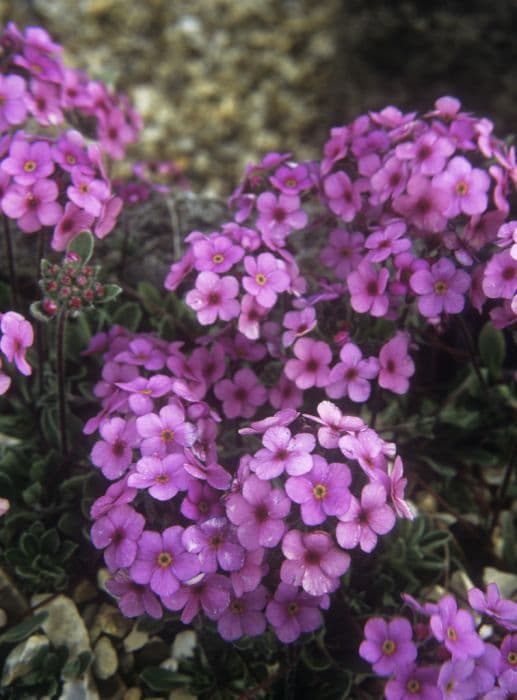Bear's ear auricula Primula auricula ambig. (Au)

ABOUT
Primula auricula, often referred to as "bear's ear" due to the shape of its leaves, is a unique and visually striking plant. Its leaves are typically fleshy and rounded with a somewhat velvety texture, exuding a soft, muted green. What sets this plant apart are its distinctive flowers, which come in a variety of colors including shades of yellow, red, pink, purple, and even bicolored patterns. Each bloom clusters at the end of a stout stem, radiating outwards with a uniform symmetry that is quite pleasing to the eye. The flowers have a tubular structure at their base and open up into a flat, circular face with five rounded petals. The center of the flower often has a contrasting color or pattern, adding to its ornamental appeal. Overall, bear's ear presents a lush, cushioned look that captivates many plant enthusiasts. The entire plant exudes an aura of hardiness, yet retains a delicate beauty through its vibrant blossoms and plush foliage.
About this plant
 Names
NamesFamily
Primulaceae.
Synonyms
Bear's Ear, Mountain Cowslip, Auricula.
Common names
Primula auricula, Auricula auricula, Primula auricula var. ciliata, Primula auricula var. purpurea, Primula ciliata.
 Toxicity
ToxicityTo humans
The common name of Primula auricula ambig. (Au) is Bear's Ear. Bear's Ear is considered non-toxic to humans. However, some people might experience contact dermatitis after handling the plant due to its irritating sap. Ingesting any part of the plant is not likely to cause poisoning or serious complications in humans.
To pets
The common name of Primula auricula ambig. (Au) is Bear's Ear. Bear's Ear is generally not considered toxic to pets such as dogs and cats. Though not commonly associated with poisoning, ingestion could potentially cause mild gastrointestinal upset in some pets. If a pet consumes a large amount of the plant, monitoring for any signs of discomfort is recommended, and a veterinarian should be consulted if any adverse reactions are observed.
 Characteristics
CharacteristicsLife cycle
Perennials
Foliage type
Evergreen
Color of leaves
Green
Flower color
Varies
Height
6 inches (15 cm)
Spread
6 inches (15 cm)
Plant type
Herb
Hardiness zones
5
Native area
Europe
Benefits
 General Benefits
General Benefits- Decorative Appeal: The Primula auricula, commonly known as Auricula or Bear's Ear, adds vibrant color and visual interest to gardens and homes with its unique and diverse range of flower colors.
- Easy to Grow: Auriculas are relatively easy to cultivate and can thrive in a variety of temperate climates, making them suitable for many gardeners.
- Extended Blooming Period: These plants have a long flowering period from mid-spring through early summer, providing consistent beauty throughout the season.
- Attracts Pollinators: The colorful flowers of the Auricula can attract beneficial pollinators like bees and butterflies, contributing to the health of your garden ecosystem.
- Diverse Cultivation Options: Auriculas can be grown in outdoor flower beds, rock gardens, alpine troughs, and as potted plants, offering flexibility for different garden spaces and styles.
- Heritage and History: The Auricula has a rich history, especially in Europe, where it was popular among 17th and 18th-century florists and remains a favorite among flower enthusiasts.
- Shows and Competitions: There is a dedicated community that grows Auriculas for shows and competitions, with the potential for gardeners to engage with others and share their passion for this particular species.
- Seed Propagation: Auriculas produce seeds that can be collected and sown, allowing gardeners to propagate new plants and develop their own varieties over time.
 Medical Properties
Medical PropertiesThis plant is not used for medical purposes.
 Air-purifying Qualities
Air-purifying QualitiesThis plant is not specifically known for air purifying qualities.
 Other Uses
Other Uses- Auriculas are often used in alpine rock gardens due to their ability to thrive in well-draining, gritty soil and their preference for cooler temperatures.
- With their bright colors and unique patterns, auriculas can be utilized for living art or as part of botanic displays in public and private gardens.
- The distinctive rosette form and lush foliage of the auricula make it a popular choice for container gardening, particularly in areas with limited space.
- Auricula flowers can be used in floral arrangements to provide an unusual and striking focus, especially in springtime bouquets.
- Some gardeners collect and display auriculas in traditional tiered theatres, a practice dating back to the 17th century, showcasing the diverse varieties as a form of competitive exhibition or personal enjoyment.
- The unique and diverse patterns of auriculas lend themselves to botanical illustration and photography, inspiring artists and hobbyists alike.
- Because of their preference for cooler conditions, auriculas are suitable for cultivation in cold frames and unheated greenhouses, extending the gardening season for enthusiasts in cooler climates.
- The auricula's compact size and minimal root system make them suitable for growing in miniature gardens or fairy gardens, adding a touch of whimsy and color.
- Specialist clubs and societies dedicated to the auricula offer opportunities for enthusiasts to share knowledge and cultivate rare or heritage varieties, preserving genetic diversity.
- Historically, auriculas have been symbolic in literature and art, representing rarity and delicate beauty, and still inspire creative works today.
Interesting Facts
 Feng Shui
Feng ShuiThe Bear's Ear is not used in Feng Shui practice.
 Plant Symbolism
Plant Symbolism- Boldness: The Auricula's striking colors in its diverse varieties symbolize courage and confidence, encouraging one to stand out in a crowd.
- Preciousness: The name 'auricula' is derived from the Latin for 'ear' and 'gold,' suggesting a connection to preciousness and value, noting the plant's unique and rich beauty.
- Uniqueness: Known for its distinct pattern, the Auricula represents individuality and the beauty of being different.
- Perseverance: As Auriculas can often withstand cold temperatures and harsh conditions, they symbolize strong will and the ability to endure difficult circumstances.
- Rarity: Due to the rarity of naturally occurring hybrids, the Auricula stands as a symbol of uniqueness and rare beauty in the plant world.
 Water
WaterAuriculas, commonly known as Bear's Ear, have specific watering needs that prevent both under- and over-watering. They prefer consistent moisture, so it's best to water them once a week with about 1 gallon of water per plant, ensuring the soil is moist but not soggy. During hot, dry periods, you may need to increase watering frequency. Always check the top inch of the soil for dryness before watering again. It is important to avoid getting water on the leaves as this can lead to disease; instead, water at the base of the plant.
 Light
LightBear's Ear thrives in bright, indirect light with protection from the hot midday sun. The ideal spot for these plants is in dappled shade, such as under a tree or on a north-facing windowsill where they can receive plenty of light without being subjected to harsh direct sunlight. Ensure to rotate your plant periodically to encourage even growth.
 Temperature
TemperatureBear's Ear prefers cooler temperatures, thriving in a range between 50°F and 75°F. They can survive temperatures as low as 20°F but it's not ideal for extended periods. Protect the plant from extreme heat and freezing conditions to prevent stress and damage.
 Pruning
PruningPruning Bear's Ear involves the removal of dead or faded flowers to encourage further blooming and maintain plant vigor. This should be done immediately after the flowers fade. Deadheading, the process of removing spent blooms, also helps prevent self-seeding and promotes a tidy appearance. Light pruning can be done throughout the blooming season as necessary.
 Cleaning
CleaningAs needed
 Soil
SoilThe Bear's Ear (Primula auricula) thrives in well-draining, slightly alkaline soil with a pH between 6.0 and 8.0. A mix containing one-part loam, one-part leaf mold or peat, and one-part perlite or grit works well. Fertilize lightly as they prefer low-nutrient conditions.
 Repotting
RepottingBear's Ear (Primula auricula) should be repotted annually, best done in late summer after flowering. Use fresh soil mix to avoid nutrient depletion and to prevent the build-up of harmful pathogens.
 Humidity & Misting
Humidity & MistingBear's Ear (Primula auricula) prefers moderate humidity levels. A range of 50-60% is ideal, but they can tolerate slightly lower levels without much harm.
 Suitable locations
Suitable locationsIndoor
Place Bear's Ear in bright, indirect light; keep soil moist.
Outdoor
Plant in partial shade with well-draining soil.
Hardiness zone
3-8 USDA
 Life cycle
Life cycleThe Bear's Ear (Primula auricula), begins its life cycle when the seeds germinate in moist, well-drained soil, typically emerging in spring. As seedlings develop, they form a rosette of leaves and establish a root system. In the second year or in some cases the first, the plant produces flowering stalks with clusters of umbrella-like flowers, which can range in color from yellow to red or purple depending on the variety, usually blooming in late spring to early summer. After pollination, typically by insects, the flowers will develop into capsules containing numerous tiny seeds. As the capsules dry, they split open to release their seeds, completing the reproductive cycle. The plant often enters a period of dormancy after flowering, with the foliage dying back and the plant surviving off stored energy in its root system until the next growing season begins.
 Propogation
PropogationPropogation time
Spring-Early Summer
Propogation: The most popular method of propagating the Primula auricula, commonly known as Auricula Primrose, is by division, which is ideally done after the plant has finished flowering in late spring or early summer. To propagate by division, one should carefully lift the plant from the soil and gently separate the clumps into smaller pieces, each with a portion of root and a few leaves. These divisions should then be replanted at the same soil depth they were growing at originally, spaced approximately 6 to 12 inches (15 to 30 centimeters) apart to ensure adequate room for growth. The soil should be well-draining and the divisions should be kept moist until they are established. Propagating Auricula Primrose in this way helps to revitalize older plants that may be centering or declining in vigor, while also increasing the number of plants in a garden.









